False Belief Understanding in Infants: A Detailed Research Analysis
VerifiedAdded on 2023/06/16
|5
|1327
|172
Report
AI Summary
This report investigates whether 15-month-old infants understand false beliefs through a nonverbal experiment. The study involved observing infants' reactions to an actor who held a false belief about the location of a toy. The methodology included presenting scenarios where the actor searched for the toy in a location where they falsely believed it to be, and the infants' gaze was tracked to gauge their expectations. The results indicated that infants do have a rudimentary understanding of false beliefs, showing surprise when the actor's actions violated their expectations. The author concluded that infants' understanding is salient but present, supporting the hypothesis that children act according to their interpretation of others' behavior. The study opens avenues for non-verbal learning methods, particularly for children with special needs, and highlights the potential for understanding cognitive capabilities in populations like autistic children. Desklib provides access to similar past papers and solved assignments for students.
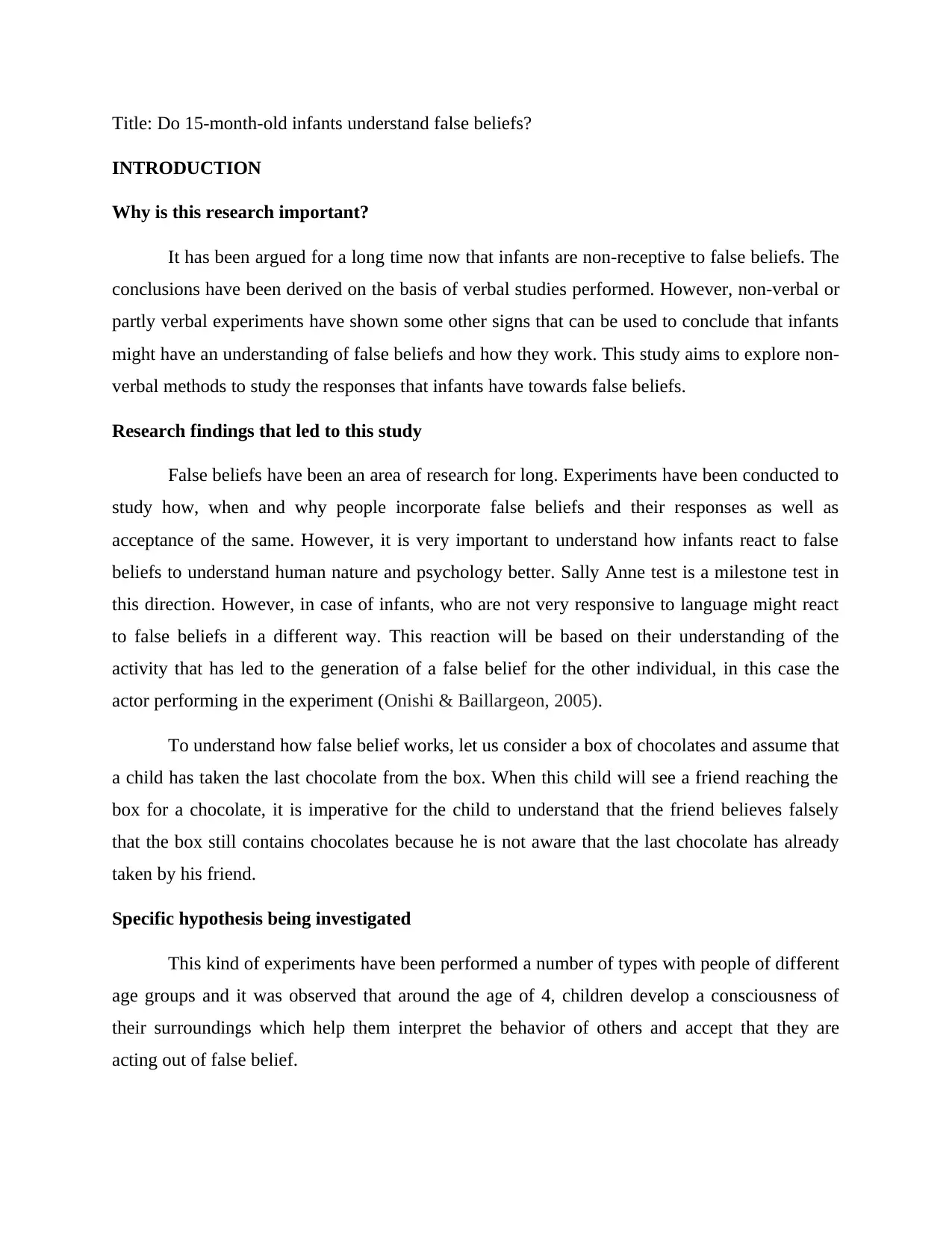
Title: Do 15-month-old infants understand false beliefs?
INTRODUCTION
Why is this research important?
It has been argued for a long time now that infants are non-receptive to false beliefs. The
conclusions have been derived on the basis of verbal studies performed. However, non-verbal or
partly verbal experiments have shown some other signs that can be used to conclude that infants
might have an understanding of false beliefs and how they work. This study aims to explore non-
verbal methods to study the responses that infants have towards false beliefs.
Research findings that led to this study
False beliefs have been an area of research for long. Experiments have been conducted to
study how, when and why people incorporate false beliefs and their responses as well as
acceptance of the same. However, it is very important to understand how infants react to false
beliefs to understand human nature and psychology better. Sally Anne test is a milestone test in
this direction. However, in case of infants, who are not very responsive to language might react
to false beliefs in a different way. This reaction will be based on their understanding of the
activity that has led to the generation of a false belief for the other individual, in this case the
actor performing in the experiment (Onishi & Baillargeon, 2005).
To understand how false belief works, let us consider a box of chocolates and assume that
a child has taken the last chocolate from the box. When this child will see a friend reaching the
box for a chocolate, it is imperative for the child to understand that the friend believes falsely
that the box still contains chocolates because he is not aware that the last chocolate has already
taken by his friend.
Specific hypothesis being investigated
This kind of experiments have been performed a number of types with people of different
age groups and it was observed that around the age of 4, children develop a consciousness of
their surroundings which help them interpret the behavior of others and accept that they are
acting out of false belief.
INTRODUCTION
Why is this research important?
It has been argued for a long time now that infants are non-receptive to false beliefs. The
conclusions have been derived on the basis of verbal studies performed. However, non-verbal or
partly verbal experiments have shown some other signs that can be used to conclude that infants
might have an understanding of false beliefs and how they work. This study aims to explore non-
verbal methods to study the responses that infants have towards false beliefs.
Research findings that led to this study
False beliefs have been an area of research for long. Experiments have been conducted to
study how, when and why people incorporate false beliefs and their responses as well as
acceptance of the same. However, it is very important to understand how infants react to false
beliefs to understand human nature and psychology better. Sally Anne test is a milestone test in
this direction. However, in case of infants, who are not very responsive to language might react
to false beliefs in a different way. This reaction will be based on their understanding of the
activity that has led to the generation of a false belief for the other individual, in this case the
actor performing in the experiment (Onishi & Baillargeon, 2005).
To understand how false belief works, let us consider a box of chocolates and assume that
a child has taken the last chocolate from the box. When this child will see a friend reaching the
box for a chocolate, it is imperative for the child to understand that the friend believes falsely
that the box still contains chocolates because he is not aware that the last chocolate has already
taken by his friend.
Specific hypothesis being investigated
This kind of experiments have been performed a number of types with people of different
age groups and it was observed that around the age of 4, children develop a consciousness of
their surroundings which help them interpret the behavior of others and accept that they are
acting out of false belief.
Paraphrase This Document
Need a fresh take? Get an instant paraphrase of this document with our AI Paraphraser
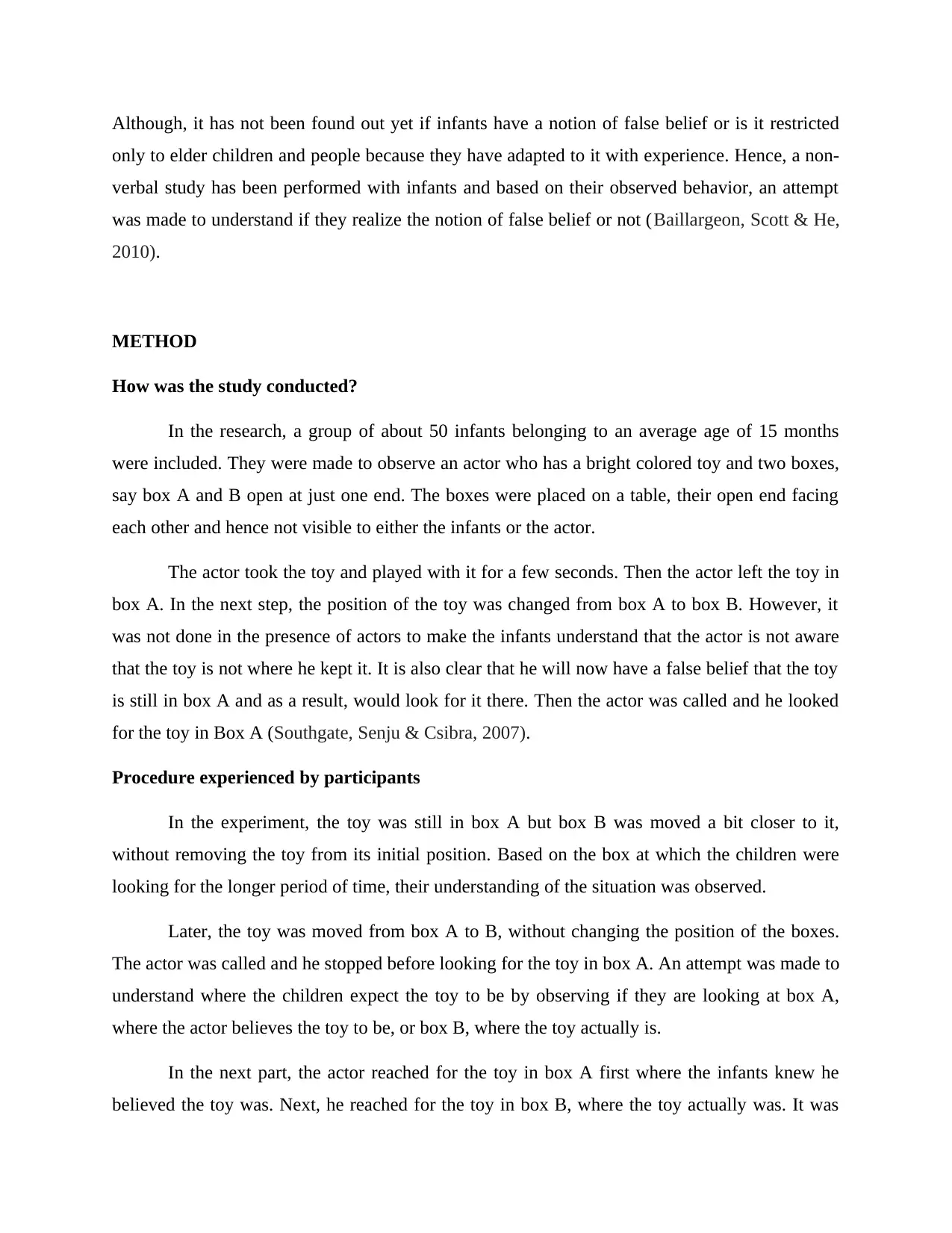
Although, it has not been found out yet if infants have a notion of false belief or is it restricted
only to elder children and people because they have adapted to it with experience. Hence, a non-
verbal study has been performed with infants and based on their observed behavior, an attempt
was made to understand if they realize the notion of false belief or not (Baillargeon, Scott & He,
2010).
METHOD
How was the study conducted?
In the research, a group of about 50 infants belonging to an average age of 15 months
were included. They were made to observe an actor who has a bright colored toy and two boxes,
say box A and B open at just one end. The boxes were placed on a table, their open end facing
each other and hence not visible to either the infants or the actor.
The actor took the toy and played with it for a few seconds. Then the actor left the toy in
box A. In the next step, the position of the toy was changed from box A to box B. However, it
was not done in the presence of actors to make the infants understand that the actor is not aware
that the toy is not where he kept it. It is also clear that he will now have a false belief that the toy
is still in box A and as a result, would look for it there. Then the actor was called and he looked
for the toy in Box A (Southgate, Senju & Csibra, 2007).
Procedure experienced by participants
In the experiment, the toy was still in box A but box B was moved a bit closer to it,
without removing the toy from its initial position. Based on the box at which the children were
looking for the longer period of time, their understanding of the situation was observed.
Later, the toy was moved from box A to B, without changing the position of the boxes.
The actor was called and he stopped before looking for the toy in box A. An attempt was made to
understand where the children expect the toy to be by observing if they are looking at box A,
where the actor believes the toy to be, or box B, where the toy actually is.
In the next part, the actor reached for the toy in box A first where the infants knew he
believed the toy was. Next, he reached for the toy in box B, where the toy actually was. It was
only to elder children and people because they have adapted to it with experience. Hence, a non-
verbal study has been performed with infants and based on their observed behavior, an attempt
was made to understand if they realize the notion of false belief or not (Baillargeon, Scott & He,
2010).
METHOD
How was the study conducted?
In the research, a group of about 50 infants belonging to an average age of 15 months
were included. They were made to observe an actor who has a bright colored toy and two boxes,
say box A and B open at just one end. The boxes were placed on a table, their open end facing
each other and hence not visible to either the infants or the actor.
The actor took the toy and played with it for a few seconds. Then the actor left the toy in
box A. In the next step, the position of the toy was changed from box A to box B. However, it
was not done in the presence of actors to make the infants understand that the actor is not aware
that the toy is not where he kept it. It is also clear that he will now have a false belief that the toy
is still in box A and as a result, would look for it there. Then the actor was called and he looked
for the toy in Box A (Southgate, Senju & Csibra, 2007).
Procedure experienced by participants
In the experiment, the toy was still in box A but box B was moved a bit closer to it,
without removing the toy from its initial position. Based on the box at which the children were
looking for the longer period of time, their understanding of the situation was observed.
Later, the toy was moved from box A to B, without changing the position of the boxes.
The actor was called and he stopped before looking for the toy in box A. An attempt was made to
understand where the children expect the toy to be by observing if they are looking at box A,
where the actor believes the toy to be, or box B, where the toy actually is.
In the next part, the actor reached for the toy in box A first where the infants knew he
believed the toy was. Next, he reached for the toy in box B, where the toy actually was. It was
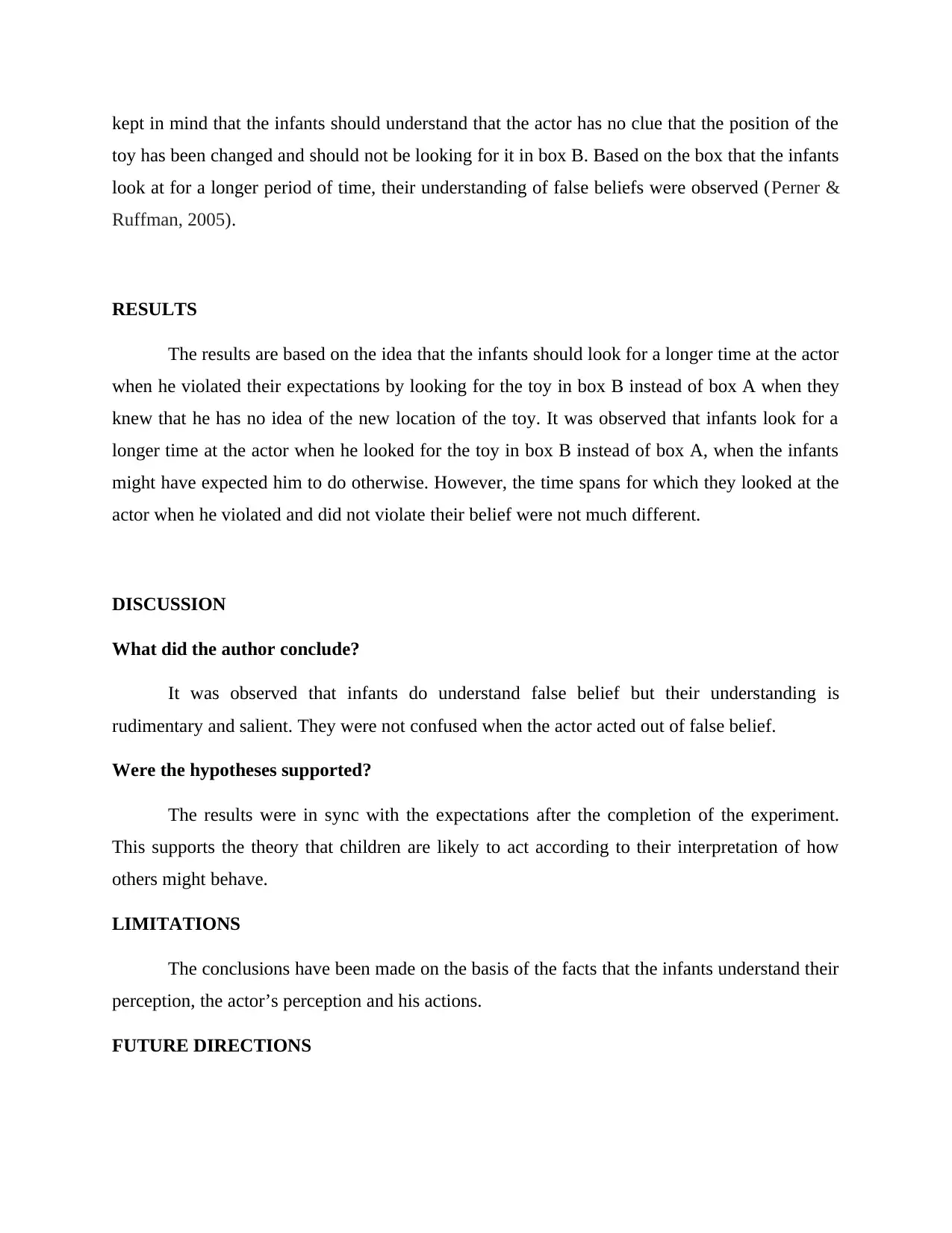
kept in mind that the infants should understand that the actor has no clue that the position of the
toy has been changed and should not be looking for it in box B. Based on the box that the infants
look at for a longer period of time, their understanding of false beliefs were observed (Perner &
Ruffman, 2005).
RESULTS
The results are based on the idea that the infants should look for a longer time at the actor
when he violated their expectations by looking for the toy in box B instead of box A when they
knew that he has no idea of the new location of the toy. It was observed that infants look for a
longer time at the actor when he looked for the toy in box B instead of box A, when the infants
might have expected him to do otherwise. However, the time spans for which they looked at the
actor when he violated and did not violate their belief were not much different.
DISCUSSION
What did the author conclude?
It was observed that infants do understand false belief but their understanding is
rudimentary and salient. They were not confused when the actor acted out of false belief.
Were the hypotheses supported?
The results were in sync with the expectations after the completion of the experiment.
This supports the theory that children are likely to act according to their interpretation of how
others might behave.
LIMITATIONS
The conclusions have been made on the basis of the facts that the infants understand their
perception, the actor’s perception and his actions.
FUTURE DIRECTIONS
toy has been changed and should not be looking for it in box B. Based on the box that the infants
look at for a longer period of time, their understanding of false beliefs were observed (Perner &
Ruffman, 2005).
RESULTS
The results are based on the idea that the infants should look for a longer time at the actor
when he violated their expectations by looking for the toy in box B instead of box A when they
knew that he has no idea of the new location of the toy. It was observed that infants look for a
longer time at the actor when he looked for the toy in box B instead of box A, when the infants
might have expected him to do otherwise. However, the time spans for which they looked at the
actor when he violated and did not violate their belief were not much different.
DISCUSSION
What did the author conclude?
It was observed that infants do understand false belief but their understanding is
rudimentary and salient. They were not confused when the actor acted out of false belief.
Were the hypotheses supported?
The results were in sync with the expectations after the completion of the experiment.
This supports the theory that children are likely to act according to their interpretation of how
others might behave.
LIMITATIONS
The conclusions have been made on the basis of the facts that the infants understand their
perception, the actor’s perception and his actions.
FUTURE DIRECTIONS
⊘ This is a preview!⊘
Do you want full access?
Subscribe today to unlock all pages.

Trusted by 1+ million students worldwide
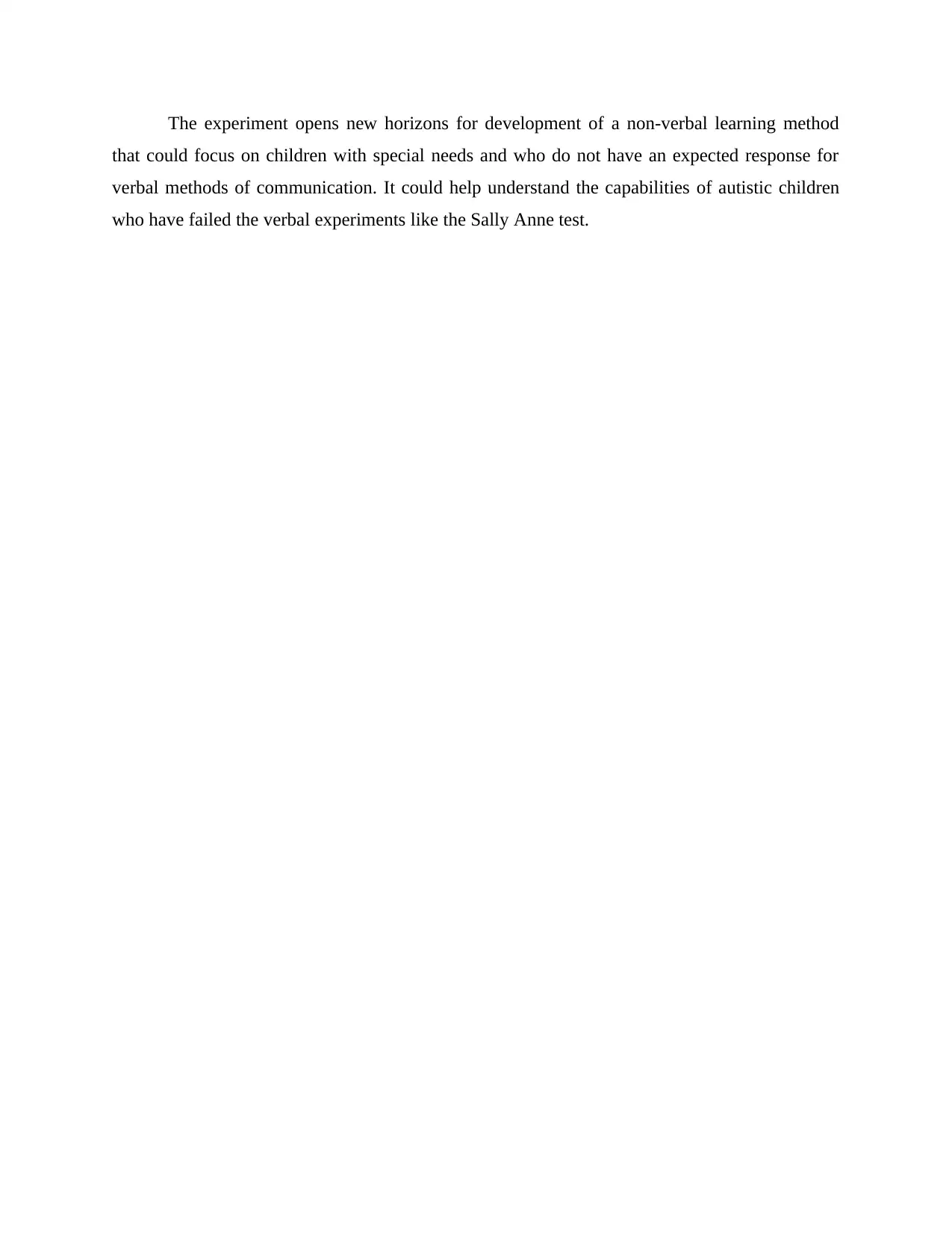
The experiment opens new horizons for development of a non-verbal learning method
that could focus on children with special needs and who do not have an expected response for
verbal methods of communication. It could help understand the capabilities of autistic children
who have failed the verbal experiments like the Sally Anne test.
that could focus on children with special needs and who do not have an expected response for
verbal methods of communication. It could help understand the capabilities of autistic children
who have failed the verbal experiments like the Sally Anne test.
Paraphrase This Document
Need a fresh take? Get an instant paraphrase of this document with our AI Paraphraser
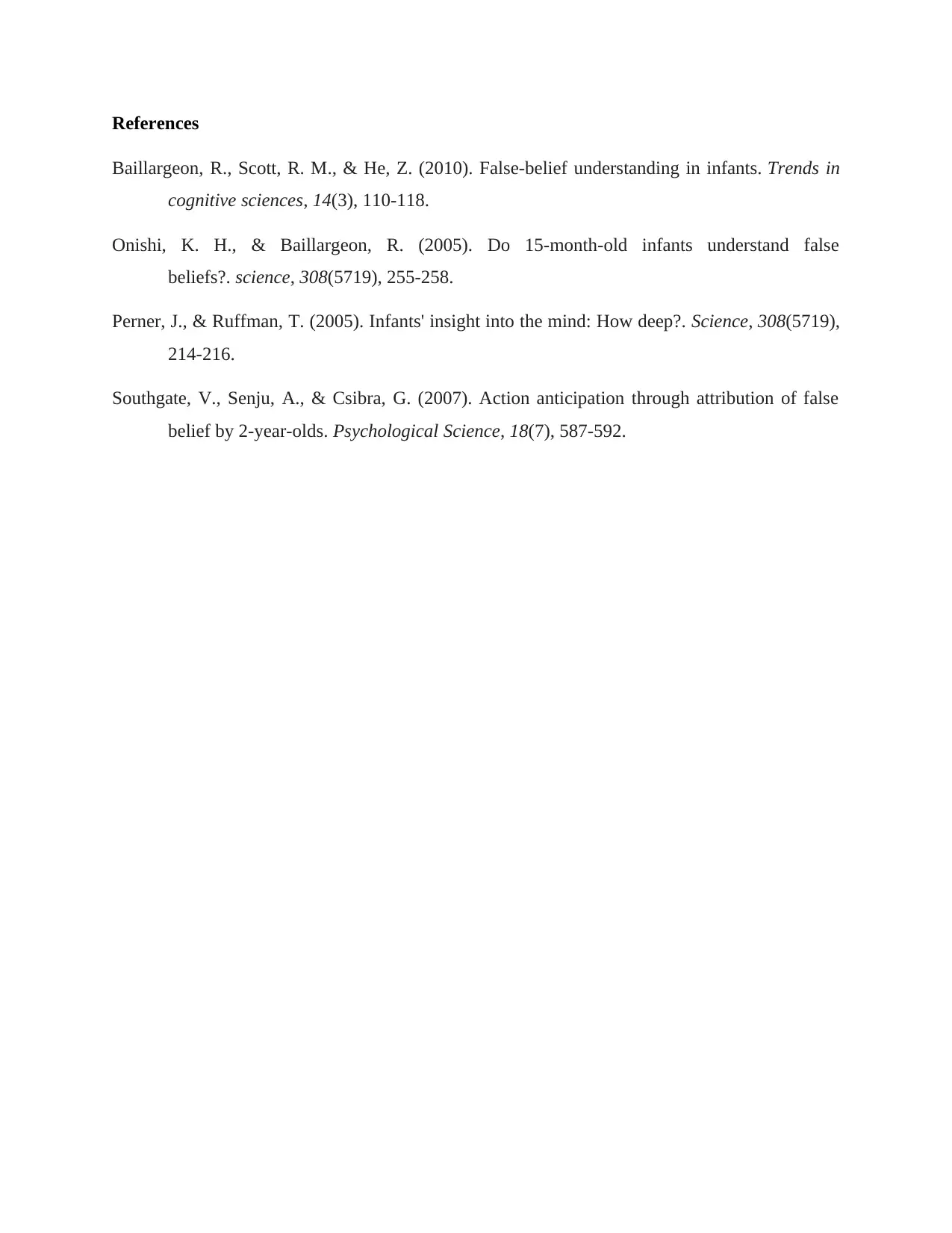
References
Baillargeon, R., Scott, R. M., & He, Z. (2010). False-belief understanding in infants. Trends in
cognitive sciences, 14(3), 110-118.
Onishi, K. H., & Baillargeon, R. (2005). Do 15-month-old infants understand false
beliefs?. science, 308(5719), 255-258.
Perner, J., & Ruffman, T. (2005). Infants' insight into the mind: How deep?. Science, 308(5719),
214-216.
Southgate, V., Senju, A., & Csibra, G. (2007). Action anticipation through attribution of false
belief by 2-year-olds. Psychological Science, 18(7), 587-592.
Baillargeon, R., Scott, R. M., & He, Z. (2010). False-belief understanding in infants. Trends in
cognitive sciences, 14(3), 110-118.
Onishi, K. H., & Baillargeon, R. (2005). Do 15-month-old infants understand false
beliefs?. science, 308(5719), 255-258.
Perner, J., & Ruffman, T. (2005). Infants' insight into the mind: How deep?. Science, 308(5719),
214-216.
Southgate, V., Senju, A., & Csibra, G. (2007). Action anticipation through attribution of false
belief by 2-year-olds. Psychological Science, 18(7), 587-592.
1 out of 5
Related Documents
Your All-in-One AI-Powered Toolkit for Academic Success.
+13062052269
info@desklib.com
Available 24*7 on WhatsApp / Email
![[object Object]](/_next/static/media/star-bottom.7253800d.svg)
Unlock your academic potential
Copyright © 2020–2025 A2Z Services. All Rights Reserved. Developed and managed by ZUCOL.





